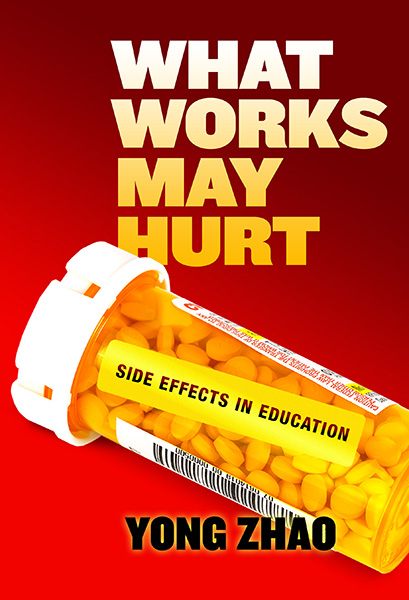Professors: Request an Exam Copy
Print copies available for US orders only. For orders outside the US, see our international distributors.
Publication Date: June 29, 2018
Pages: 176

Medical products are required to disclose both their intended outcomes and known side effects. Educational policy and practice, however, carry no such labels. Thus, teachers, school leaders, and the public are not told, for example, that “this program helps improve your students’ reading scores, but it may make them hate reading forever,” or that “school choice may improve test scores of some students, but it may lead to the collapse of American public education.”
In his new book, Yong Zhao, distinguished professor and specialist in education policy, shines a light on the long-ignored phenomenon of side effects of education policies and practices, bringing a fresh and perhaps surprising perspective to evidence-based practices and policies. Identifying the adverse effects of some of the “best” educational interventions with examples from classrooms to boardrooms, the author investigates causes and offers clear recommendations.
This volume will help the field of education to advance beyond the extreme pendulum swings that characterize today’s school reform efforts.
Book Features:
Yong Zhao is a Foundation Distinguished Professor in the School of Education at the University of Kansas and a professorial fellow at the Mitchell Institute for Health and Education Policy at Victoria University in Australia. He is a recipient of the Early Career Award from the American Educational Research Association and is an elected fellow of the International Academy for Education.
“Zhao’s audience of educational researchers, faculty of higher education, school administrators, and classroom teachers will not only be intrigued by Zhao’s findings, but inspired to advocate for a much-needed shift in how educational initiatives are brought into schools.”
—Teachers College Record
“In "What Works May Hurt: Side Effects in Education" Professor Zhao draws upon his years of research, experience and expertise in the area of educational reforms. . . very highly recommended for school district, college, and university Educational Issues & Teacher Education collections.”
—Midwest Book Review, Wisconsin Bookwatch
“Yong Zhao has written a highly readable and important book about the side effects—the unintended consequences—of education reforms. Every educator and researcher should read this book and take its lessons to heart.”
—Diane Ravitch, New York University
"As he did in Who’s Afraid of the Big Bad Dragon, Yong Zhao has again produced a stunning analysis of the problems encountered in our efforts to improve education. In What Works May Hurt, he has succeeded in demonstrating that the schooling of youngsters is at least as complex as marriage, war, or religion. If he has not delivered the death blow to naive empiricism, he has at least severely wounded it."
—Gene V. Glass, San José State University
"What Works May Hurt puts together a convincing argument, supported by a wide range of evidence, that we must begin to mind the unintended side effects of educational ‘treatments’ just as we have done with medical procedures and products. This book is a brilliantly written analysis of well-known educational change efforts followed by a concrete call for action that no policymaker, researcher, teacher, or education reform advocate should leave unread. If taken to action, Yong Zhao could become a long-awaited peacemaker in century-old political and educational rivalries and an advisor to those who hold the power to design sustainable education policies to benefit all the children in the United States and beyond."
—Pasi Sahlberg, Professor of Education Policy, Gonski Institute for Education, University of New South Wales, Sydney
“In this wonderful and crucial book, Zhao has made clear that the obsession with testing in our public schools has hurt students, teachers, and the quality of the citizens produced by our schools. Nothing less than the future of the republic is dealt with in this most thoughtful book about the field of educational research and policy.”
—David C. Berliner, Regents’ Professor Emeritus, Arizona State University
Contents
Acknowledgments vii
Introduction 1
1. When Risks Outweigh Benefits: The Effectiveness, Effects, and Side Effects of NCLB 7
The Diagnosis and Prescription 7
The Effects and Effectiveness of NCLB 11
Side Effects of NCLB 15
Summary 21
2. The Missed Lesson from Medical Research for Education: Why Randomized Controlled Trials (RCT) Couldn’t Cure Reading First 24
The Case of Reading First 24
Side Effects: The Missed Lesson from Medicine 32
Moving Beyond RCT: A Summary 36
3. Unproductive Successes and Productive Failures: Direct Instruction and Classroom Side Effects 38
The Grievance of Direct Instruction 40
Effectiveness Versus Effects of Direct Instruction 43
Effects and Side Effects of Direct Instruction 50
Summary 54
4. At What Cost: Side Effects at the System Level in East Asia 56
The Surprising Admiration for East Asian Education 56
Evidence of Effectiveness 57
The Asian Treatment 60
Asian Treatment at Work: Effects and Side Effects 65
Summary 74
5. The Rabbit Hole of Visible Learning:Invisible Side Effects Lurk Ahead 75
Many Educational Outcomes 78
An Ecological Metaphor 79
Outcomes Versus Outcomes: Side Effects of Pursuing Academic Achievement 82
Summary 88
6. From When Is It Effective to Who Gets Hurt: When Vouchers Don’t Work 89
Aptitude–Treatment Interaction 90
Lessons from ATI Research 92
From Effects to Side Effects 94
Who Gets Hurt: The Case of School Vouchers 96
Summary 103
7. The Futile Quest for Panacea: Wars, Pendulum Swings, and Snake Oil in Education 104
Cyclical Warfare and Pendulum Swings in Education 105
The Elusive Middle Ground 109
The Quest for Panacea 110
Neglecting Side Effects 114
Raging Wars and New Panacea: A Summary 116
8. Study Side Effects Now: A Call to Action 118
Why Study Side Effects? 119
Why Haven’t We? 126
A Call to Action 128
Side Effects of Studying Side Effects: Conclusion 132
References 133
Index 156
About the Author 168
Professors: Request an Exam Copy
Print copies available for US orders only. For orders outside the US, see our international distributors.